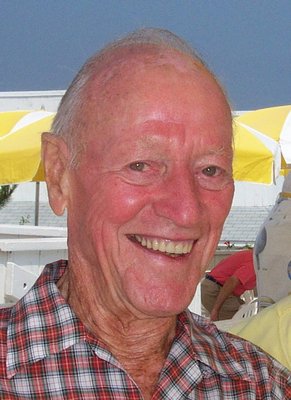
Longtime Quogue resident Henry Gardiner—a direct descendant of Lion Gardiner, who purchased what is now known as Gardiners Island from the Montaukett tribe in 1639—died at his home in Hightstown, New Jersey, on May 27, two days after his 98th birthday.Known as “Hank” to his many friends and family, Mr. Gardiner worked for 25 years at the American Museum of Natural History in New York, where he was supervisor of exhibition design.
He was the great-grandson of Henry Gardiner (1789-1867), a whaling captain from Bellport who purchased what is still the Gardiner home in Quogue today, on Quogue Street, along with a number of other parcels in the village.
Captain Gardiner’s only son, also named Henry (1833-1925), inherited these holdings and bought more properties, running a number of them as hotels for the summer trade. He also taught school in the building known as the Old Schoolhouse Museum, now located behind the Quogue Library on Quogue Street.
At one time around the turn of the 20th century, the Gardiner and Post families were the principal landholders in Quogue.
Hank Gardiner was born May 25, 1916, to Henry Halsey Gardiner and his wife, Marion, in Schenectady, New York, where his father, known to all as “Happy,” worked for General Electric. Hank grew up in Schenectady, spending summer vacations with his parents in Quogue, until his father retired from the company and moved full time to Quogue to work in real estate.
After graduating from the Hotchkiss School in Connecticut, Mr. Gardiner went to Princeton, where he earned a bachelor’s degree in art history in 1938. From 1938 to 1942, he taught Latin, Greek, Spanish and history at Hotchkiss and the Romford School.
He served in the U.S. Air Force as a B24 pilot in the European Theater from 1942 to 1945, rising in rank from private to captain. After the war, he earned another bachelor’s degree, this one in visual design, from the Institute of Design in Chicago in 1949.
Later the same year, Mr. Gardiner got a job working in Aspen, Colorado, with Herbert Bayer, a former student and teacher of the Bauhaus school in Germany. Among other projects, the two men worked for four years on the design of a “World Geo-Graphic Atlas” for the Container Corporation of America.
He returned to New York in 1953, working as a freelance designer on book jackets, record albums, advertising and magazine layout, including a brief stint as assistant art director for Harper’s Bazaar magazine. He applied for a freelance graphic artist position at the American Museum of Natural History in 1954 and was surprised and delighted when he was offered a full-time position designing exhibitions.
In 1956, he was loaned out by the museum to the U.S. Department of Commerce to work on the U.S. Pavilion in Izmir for Turkey’s International Trade Fair that year.
During his 25-year tenure at the museum, Mr. Gardiner was responsible for the design and creation of major exhibition spaces, including: the Hall of Biology of Man in 1961; Hall of Man in Africa in 1968; Hall of Mexico and Central America in 1970; the Natural Science Center in 1974; and the Hall of Mollusks and Mankind in 1975.
Prior to his retirement from the museum in 1979, he oversaw the design and installation of three temporary exhibitions: “Treasures of Cyprus” in 1976; “Peru’s Golden Treasures” in 1977; and “Ice Age Art” in 1978.
In a profile of Mr. Gardiner that appeared in the Alpine Press in New Jersey in 1962, Helen Strauss wrote that his exhibition spaces represented “visual design and graphic depiction raised to the highest power. His aim has been to create an ‘experience’ rather than make one feel he is looking at an ‘exhibit in a box.’”
In 1940, Mr. Gardiner married Winifred “Winnie” Wylie, whom he had met in Quogue. From 1950 to 1979, the couple lived in Alpine, New Jersey, raising their two sons, Henry Hawthorne (“Hap”) Gardiner and John Lion Gardiner there and, in the summers, in Quogue. In Alpine, Mr. Gardiner served for a time as the president of the school board. After his retirement from the museum in 1979, the couple moved to Quogue full time.
The first Mrs. Gardiner died in 1986, and in 1989 Mr. Gardiner married Katharine Emmet Bramwell of Princeton, New Jersey. The couple moved first to Princeton and then to Meadow Lakes a few miles east of Princeton and continued to summer in Quogue until the second Mrs. Gardiner’s death in 2003.
Mr. Gardiner enjoyed all outdoor pursuits, especially skating on frozen lakes and hiking in the woods around Schenectady when he was younger and swimming in the ocean throughout his life in Quogue, where he was a member of the Quogue Field Club and the Quogue Beach Club.
Beyond his work in interpretive design and graphic arts, he looked at the world through an artist’s eyes and found joy in painting, principally landscapes. He frequently exhibited his work locally in the annual Quogue Historical Society Art Show.
Predeceased by his brother, John Lion Gardiner, in 1957, Mr. Gardiner is survived by two sons, Henry Hawthorne Gardiner and his wife Josephine Bradford Gile of Cheyenne, Wyoming; John Lion Gardiner and his wife Kathleen Maley of Pittsburgh, Pennsylvania; a niece, Margaret Halsey (“Pi”) Gardiner of Quogue and New York; three granddaughters, Bradford Louise Gardiner, Winifred Nannette Gardiner and Maureen Gardiner; a great-niece, Halsey Anderson; a great-nephew, Gardiner Anderson; and a great-grandnephew, Leo Anderson.
A private celebration of Mr. Gardiner’s life was held in Quogue in September. Memorial donations to the Quogue Wildlife Refuge, P.O. Box 492, Quogue, NY 11959 would be appreciated by the family.